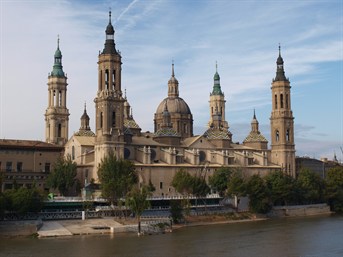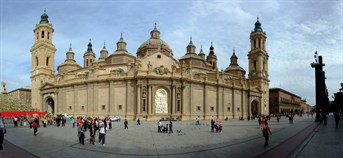The basilica de Nuestra Señora del Pilar of Zaragoza
 The basilica of Nuestra Señora del Pilar (Our Lady of Pilar) is one of two cathedrals in Zaragoza, and the largest Baroque church in Spain. In it preserves the column (Pilar) on which, according to tradition, the Virgin Mary, at the time still living in Jerusalem, appeared to the Apostle Santiago. To remember and celebrate the miraculous event, a small chapel was built on the site, later replaced by a Romanesque church, then a Gothic Mudéjar one and a direct antecedent of the Baroque cathedral. It was Don Juan José de Austria, at that time viceroy of Aragon, who promoted the construction of a church in Baroque style, upon which work began in 1681. Royal architect Francisco de Herrera el MozoFrancisco Herrera called el Mozo (1627-1685) was a Baroque painter and architect, the son of Herrera el Viejo. Born in Seville, after having worked with his father, he moved to Italy in his early twenties to complete his training. After returning to Spain, his reputation grew quickly until he came to the court as the court painter of King Charles II and Maestro Mayor de las Obras Reales. He died in 1685, while working at the Basilica del Pilar in Zaragoza., and with him other maestros de obras such as Felipe SánchezFelipe Sánchez was an architect born in Zaragoza, famous for having contributed to the construction of the Basilica of Nuestra Señora del Pilar. He died in Madrid in 1709., directed the construction of the work. Some decades later, Ferdinand VI entrusted the construction of the Santa Capilla to Ventura RodríguezTizón Buenaventura Rodríguez, better known as Ventura Rodríguez (1717-1785) is regarded as the last Spanish Baroque architect, although his production already had elements typical of Neoclassicism. Among his works are the inside of the Monastery of the Encarnación (Incarnation), the exterior of the Palace of Liria and the design of the fountain of Cibeles in Madrid, the façade of the convent of the Agustinos Filipinos in Valladolid and the Santa Capilla of the Basilica of Nuestra Señora del Pilar (Our Lady of Pilar) in Zaragoza.. Rodríguez also introduced changes in the decoration of the interior, giving the cathedral a more sober style and closer to Neo-classical style. Already of considerable size (130 metres long, 67 wide), the Basilica was further enriched by numerous domes and towers, erected from the late nineteenth century to the twentieth century.
The basilica of Nuestra Señora del Pilar (Our Lady of Pilar) is one of two cathedrals in Zaragoza, and the largest Baroque church in Spain. In it preserves the column (Pilar) on which, according to tradition, the Virgin Mary, at the time still living in Jerusalem, appeared to the Apostle Santiago. To remember and celebrate the miraculous event, a small chapel was built on the site, later replaced by a Romanesque church, then a Gothic Mudéjar one and a direct antecedent of the Baroque cathedral. It was Don Juan José de Austria, at that time viceroy of Aragon, who promoted the construction of a church in Baroque style, upon which work began in 1681. Royal architect Francisco de Herrera el MozoFrancisco Herrera called el Mozo (1627-1685) was a Baroque painter and architect, the son of Herrera el Viejo. Born in Seville, after having worked with his father, he moved to Italy in his early twenties to complete his training. After returning to Spain, his reputation grew quickly until he came to the court as the court painter of King Charles II and Maestro Mayor de las Obras Reales. He died in 1685, while working at the Basilica del Pilar in Zaragoza., and with him other maestros de obras such as Felipe SánchezFelipe Sánchez was an architect born in Zaragoza, famous for having contributed to the construction of the Basilica of Nuestra Señora del Pilar. He died in Madrid in 1709., directed the construction of the work. Some decades later, Ferdinand VI entrusted the construction of the Santa Capilla to Ventura RodríguezTizón Buenaventura Rodríguez, better known as Ventura Rodríguez (1717-1785) is regarded as the last Spanish Baroque architect, although his production already had elements typical of Neoclassicism. Among his works are the inside of the Monastery of the Encarnación (Incarnation), the exterior of the Palace of Liria and the design of the fountain of Cibeles in Madrid, the façade of the convent of the Agustinos Filipinos in Valladolid and the Santa Capilla of the Basilica of Nuestra Señora del Pilar (Our Lady of Pilar) in Zaragoza.. Rodríguez also introduced changes in the decoration of the interior, giving the cathedral a more sober style and closer to Neo-classical style. Already of considerable size (130 metres long, 67 wide), the Basilica was further enriched by numerous domes and towers, erected from the late nineteenth century to the twentieth century.
The structure of the cathedral has three naves, covered with barrel vaults and defined by large pillars. On them rest the numerous domes, eleven in total, which characterize the profile of the entire cathedral. The interior of the domes and vaults were designed to be painted, but this happened only in part. Among the frescoed domes are those that surround the Santa Capilla, one of which was dedicated to the Reina de los Mártires (Queen of Martyrs), which was painted by the famous Francisco Goya. In the nave, under the central dome, lies the altar. The retablo mayor de la Asunción (Main retable of the Assumption), from the early sixteenth century by the sculptor Damián FormentDamián Forment (1480-1540) was a sculptor from Valencia, considered one of the first introducers of the Renaissance in Spain., presides over the main altar and is one of the most significant artistic elements of the cathedral.
The aforementioned Santa Capilla was built from a design by Ventura Rodríguez between 1750 and 1765 even though the work was largely led by José Ramírez de ArellanoJosé Ramírez de Arellano (1705-1770) was a Spanish Baroque architect and sculptor. In 1740 he was appointed Sculptor of the king and in 1758 entered the Real Academia de Bellas Artes de San Fernando.. The chapel presents a separate building within the structure, a synthesis of Baroque sculpture and architecture with evident Classical influences. Located in the second bay of the nave, it has a Greek cross plan with a central elliptical dome. The curvy design, the three altars, columns, medallions and sculptures, all made with high quality materials such as marble, bronze and jasper, act as a cornice for the column and the image of the Virgin, which has remained in the same position in which, according to tradition, she appeared to the Apostle Santiago. The wooden statue of the Virgin, 38 cm high, is in this way the center of attention of the faithful.
 The same late-eighteenth-century late Baroque style which is of Italian inspiration and is inspired particularly by Borromini, but with clear elements of Neoclassical art, is also visible in other large chapels arranged inside the cathedral: the Capilla de San Juan Bautista (Chapel of Saint John the Baptist), the Capilla de Santa Ana (Chapel of Saint Anne), the Capilla de San José (Chapel of Saint Joseph), the Capilla de San Antonio de Padua (Chapel of Saint Anthony of Padua), the Capilla de San Agustín (Chapel of Saint Augustine) or the Parroquia del Pilar (Parish of the Pilar), the Capilla de San Lorenzo, (Chapel of Saint Lawrence) the Capilla de Santiago (Chapel of Saint Lawrence) or de la Comunión (the Communion). Baroque elements are also visible in the Sacristía Mayor (Main Sacristy), which, however, is not open to the public, the Capilla del Rosario (Chapel of the Rosary) and the Museo del Pilar, located in the old hall of the Cathedral de oración (Cathedral of Prayer).
The same late-eighteenth-century late Baroque style which is of Italian inspiration and is inspired particularly by Borromini, but with clear elements of Neoclassical art, is also visible in other large chapels arranged inside the cathedral: the Capilla de San Juan Bautista (Chapel of Saint John the Baptist), the Capilla de Santa Ana (Chapel of Saint Anne), the Capilla de San José (Chapel of Saint Joseph), the Capilla de San Antonio de Padua (Chapel of Saint Anthony of Padua), the Capilla de San Agustín (Chapel of Saint Augustine) or the Parroquia del Pilar (Parish of the Pilar), the Capilla de San Lorenzo, (Chapel of Saint Lawrence) the Capilla de Santiago (Chapel of Saint Lawrence) or de la Comunión (the Communion). Baroque elements are also visible in the Sacristía Mayor (Main Sacristy), which, however, is not open to the public, the Capilla del Rosario (Chapel of the Rosary) and the Museo del Pilar, located in the old hall of the Cathedral de oración (Cathedral of Prayer).
The exterior of the basilica, in red brick, is characterized by its impressive shapes and sizes. Eleven domes stand out, culminating in lanterns and are covered with colored tiles. The central dome, located at the confluence between the central nave and the fourth of the seven bays that divide the cathedral, is the largest. Two smaller domes, placed at the sides of the central nave, in correspondence with the second and sixth bay are in turn are surrounded at the corners by four smaller domes, arranged on the first, third, fifth and seventh bay of both naves. The four towers, more than three hundred metres high, were mostly erected during the twentieth century.
